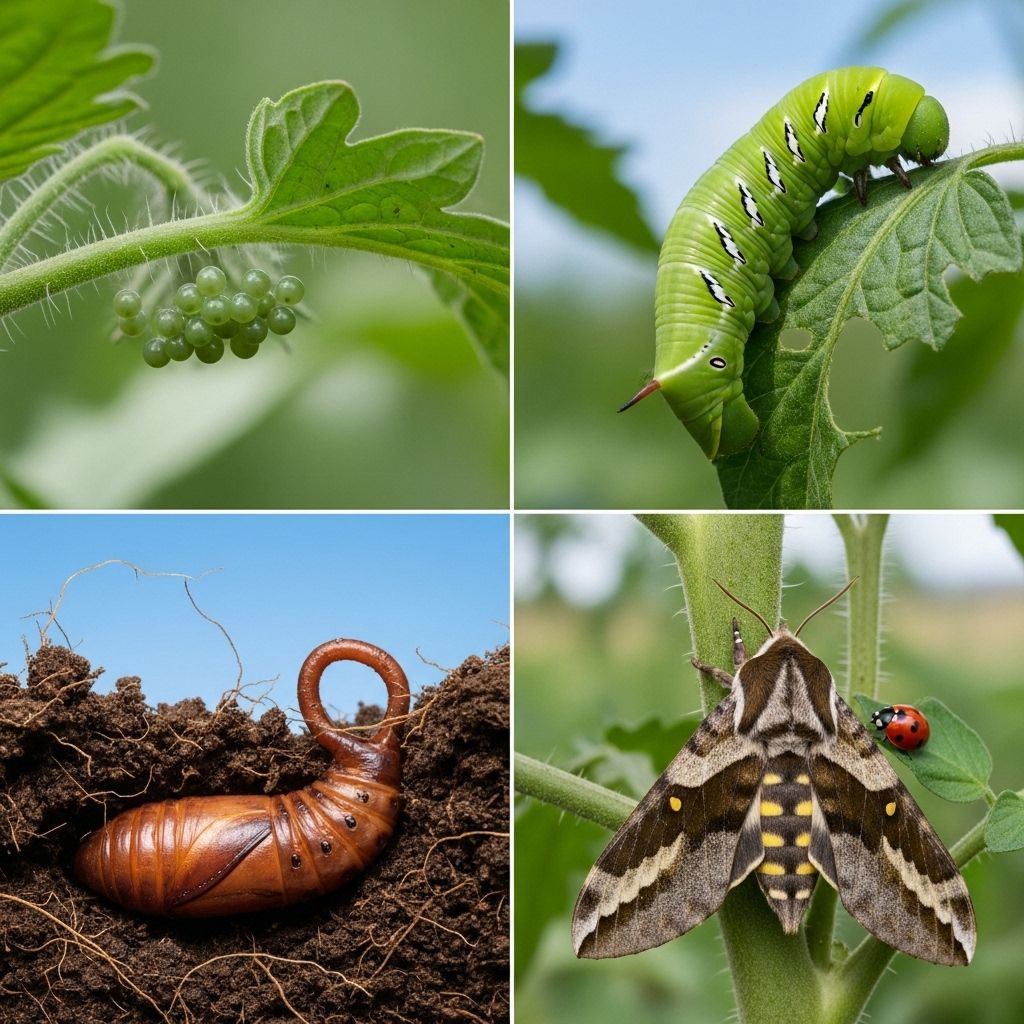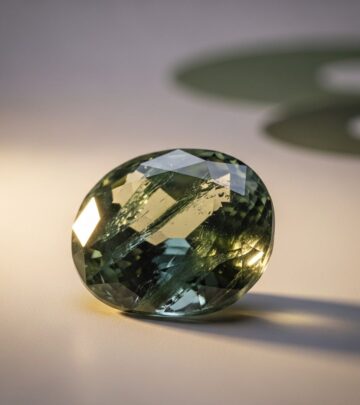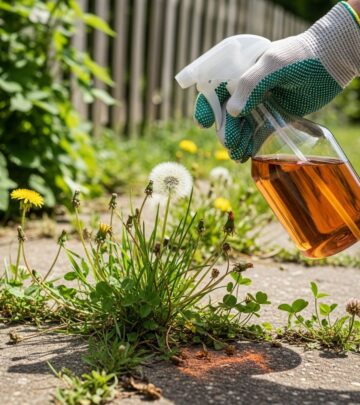Tomato Hornworm Life Cycle: 4 Stages Explained & Control Tips
From tiny eggs to giant caterpillars and moths, explore the life cycle, identification, damage, and control of tomato hornworms in your garden.

Image: HearthJunction Design Team
Tomato Hornworm Life Cycle: A Comprehensive Guide
The tomato hornworm (Manduca quinquemaculata) is a common and formidable garden pest known for its voracious appetite and striking appearance. Understanding its life cycle, identification, damage patterns, and effective control methods is essential for any home gardener eager to protect their tomatoes and related crops. This article guides you through every stage of the hornworm’s journey, from egg to imposing moth, and offers practical measures for managing infestations in your vegetable garden.
What Is a Tomato Hornworm?
The tomato hornworm is the larval stage of a large moth sometimes called the sphinx, hawk, or hummingbird moth. These caterpillars are among the largest found in North American gardens, often growing up to four inches in length. Despite their size, hornworms blend remarkably well with tomato foliage, making them difficult to spot until significant damage occurs.
- Scientific name: Manduca quinquemaculata
- Family: Sphingidae
- Commonly affects: Tomatoes, eggplants, peppers, potatoes, and related plants
Hornworm Identification
Proper identification is the first step in controlling this pest. Here’s how to distinguish the tomato hornworm in its various stages:
Eggs
- Small, oval, and smooth
- Pale green in color
- Laid singly on the upper and lower surfaces of leaves
Larvae (Caterpillars)
- Vivid green with fine, white diagonal stripes on each side
- Prominent curved horn (usually dark-colored) on the rear segment
- Grow rapidly, reaching up to 4 inches long
- Leave large, dark green, or black droppings on foliage and soil beneath feeding sites
Pupa
- Cylindrical, brown, and buried in soil
- Remains dormant during winter months
Adult Moth
- Large, heavy-bodied with mottled gray-brown coloring
- Wingspan of 4 to 5 inches
- Narrow front wings with alternating bands on the hindwings
- Distinctive yellow spots on the sides of the abdomen
The Tomato Hornworm Life Cycle
The life cycle of the tomato hornworm is an intriguing journey through four distinct stages: egg, larva (caterpillar), pupa, and adult moth. Understanding each stage can help you time your pest management strategies for maximum effectiveness.
Egg Stage
- In late spring, adult moths emerge from overwintering sites in the soil.
- After mating, females lay their eggs singly on host plants, especially tomatoes.
- Eggs hatch in five to seven days, depending on temperature and conditions.
Larval (Caterpillar) Stage
- Newly hatched larvae begin feeding immediately on foliage and sometimes fruit.
- They grow rapidly, molting multiple times over three to four weeks.
- This is the only stage that causes noticeable plant damage.
“Caterpillars hatch, begin to feed, and are full-grown in three to four weeks. The mature caterpillars drop off plants and burrow into the soil to pupate.”
Pupal Stage
- When mature, larvae drop to the ground and burrow several inches into the soil.
- They form a brown pupal case and remain underground for two to four weeks during the growing season.
- For those pupating in late summer or fall, this stage lasts through winter until the following spring.
Adult Moth Stage
- Adult sphinx moths emerge from the soil, usually in late spring or early summer.
- After mating, the cycle begins again with the next generation of eggs.
Generational Patterns
- In warmer climates, two generations can occur each year.
- The first generation appears by mid-July, with a second wave from early August through early October.
- In colder regions, only a single generation is typical.
Host Plants and Preferred Habitat
Tomato hornworms primarily target members of the nightshade family (Solanaceae), with tomato plants being the most frequent victims. However, they can also infest:
- Eggplants
- Peppers
- Potatoes
- Occasionally, related wild plants
Damage Caused by Tomato Hornworms
The larval or caterpillar stage is responsible for all feeding damage. As they grow, hornworms can defoliate whole plants seemingly overnight, especially when populations are high.
- Chewed leaves: Large, irregular holes appear in foliage, starting at the uppermost branches.
- Missing stems: Entire sections, including stems and petioles, may disappear.
- Fruit damage: Hornworms sometimes take bites out of green fruit, leaving shallow scars.
- Droppings: Large, dark green or black frass often accumulates beneath feeding areas, helping gardeners detect an otherwise hidden pest.
Natural Predators and Biological Control
Fortunately, tomato hornworm populations are usually kept in check by a robust suite of natural enemies. Many gardeners find caterpillars hosting rows of white, oblong cocoons — a sign of parasitic wasps at work.
- Parasitic Wasps (e.g., Trichogramma, Cotesia congregata): These lay eggs on or inside hornworm larvae. The wasp larvae feed on the caterpillar and eventually kill it.
- Generalist Predators: Birds, predatory bugs, and spiders prey on hornworm eggs and larvae.
- Bacillus thuringiensis (Bt): This naturally occurring bacterium is highly effective against young caterpillars when applied to foliage.
- Spinosad: An organic insecticide that can target small hornworm larvae without harming most beneficial insects.
Manual and Cultural Control Techniques
While natural enemies play a vital role, gardeners can use additional strategies to limit hornworm damage:
- Handpicking: Inspect plants daily for caterpillars and remove them by hand. Hornworms are harmless to humans and easily disposed of.
- Snipping: For those squeamish about handpicking, use garden shears to clip caterpillars off plants.
- Soil Tillage: Discing or rototilling the soil after harvest destroys pupae and reduces adult emergence in spring.
- Crop Rotation: Rotating nightshade crops year to year can disrupt hornworm life cycles.
- Remove Weeds: Eliminate nightshade family weeds, which can serve as alternative hosts.
Integrated Pest Management (IPM) for Tomator Hornworms
A successful hornworm management plan combines biological, manual, and cultural techniques. Chemical intervention is rarely necessary except during heavy infestations. Key steps include:
- Frequent inspection during midsummer, when larvae are most active
- Supporting natural enemies by minimizing broad-spectrum insecticide use
- Prompt removal of caterpillars and damaged foliage
- Soil sanitation in autumn to destroy overwintering pupae
Seasonal Patterns and Regional Variation
Hornworm infestations may peak at different times depending on climate. In warm, inland gardens, midsummer brings the largest populations. A smaller second peak may occur in late summer, especially in regions that support two generations per year.
Comparison Table: Tomato Hornworm vs. Tobacco Hornworm
| Feature | Tomato Hornworm (Manduca quinquemaculata) | Tobacco Hornworm (Manduca sexta) |
|---|---|---|
| Horn Color | Dark blue or black | Red |
| Lateral Stripes | Eight V-shaped, white stripes | Seven diagonal, white lines |
| Preferred Host | Tomato | Tobacco, tomato |
Frequently Asked Questions (FAQs)
How can I spot hornworm eggs on my tomatoes?
Look for tiny, pale green, oval eggs on both the upper and lower sides of leaves, especially near the plant’s growing tips.
Why are hornworms so hard to find?
Their green color and striping blend perfectly with tomato plants, making them masters of camouflage until significant feeding damage becomes evident.
Do tomato hornworms turn into butterflies?
No. Tomato hornworms mature into large sphinx or hawk moths, which are often mistaken for hummingbirds due to their size and flight pattern.
What happens if I see a hornworm with white cocoons on its back?
Leave it alone! Those white cocoons belong to beneficial parasitic wasps whose larvae are consuming the hornworm from the inside out, preventing it from causing further damage.
Can hornworms survive winter?
Yes. The pupal stage overwinters in the soil and emerges as an adult moth the following spring.
Are hornworms harmful to humans?
No. Despite their intimidating appearance, hornworms do not bite or sting humans.
What should I do if I have a severe hornworm infestation?
Combine manual removal, support natural predators like parasitic wasps, apply organic solutions such as Bt or spinosad for young larvae, and till garden soil in fall to destroy pupae.
Conclusion
The tomato hornworm is a formidable pest, but understanding its life cycle unlocks the best strategies for effective control. By learning to identify its stages, supporting its natural enemies, and employing simple manual and cultural management techniques, gardeners can confidently minimize hornworm damage and enjoy a healthier, more productive vegetable garden season after season.
References
- https://extension.umn.edu/yard-and-garden-insects/tomato-hornworms
- https://extension.okstate.edu/programs/digital-diagnostics/insects-and-arthropods/tomato-hornworm-manduca-quinquemaculata-tobacco-hornworm-manduca-sexta/
- https://www.maine.gov/dacf/php/gotpests/bugs/documents/tom-hornworm-minn.pdf
- https://ipm.ucanr.edu/PMG/GARDEN/VEGES/PESTS/hornworm.html
- https://www.youtube.com/watch?v=GiwEnAi95RU
Read full bio of Shinta










